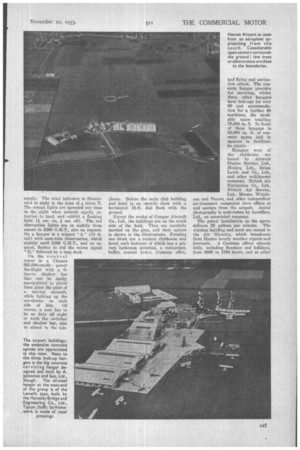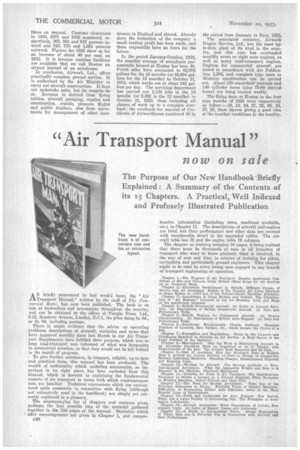HESTO Al
Page 76

Page 77

Page 78

If you've noticed an error in this article please click here to report it so we can fix it.
PO
Following Up Last Month's Article on Aerodrome Requirements, a Typical Aerodrome is Described
IN the Air Transport Supplement for October we explained, with diagrams and sketches, the requirements of an aerodrome site. This month it has been decided to describe a particular aerodrome that may be taken as answering those requirements satisfactorily on most counts. The equipment, as well as the geographical features, will be noted, so that an idea of the financial outlay can be gained.
Heston Airport has been selected hecause (a) it is a good aerodrome ; (b) it has been planned well ahead, its present state representing but a stage in a development schemed for at least the next 10 years. The proprietary company is Airwork, Ltd., formed on October 28, 1928, with an authorized capital of 155,000. It owes its existence to the enterprise -of Mr. Nigel Nortnan and Mr. Alan Muntz.
Mr. Norman, the chairman, has been largely responsible for the design of aerodrome and buildings; Mr. bruntz is the managing director and negotiated the formation, in June, 1932, in conjunction with the! Egyptian State Bank, of Misr Airwork, S.A.E., also the extension of operations into Iraq. Mr. Roderick Denman, an electrical engineer, joined the other two in April, 1931, and is technical director. All three were at Trinity College, Cambridge.
Heston 'Airport is 114 miles west by south of London (Charing Cross), with which it is not as yet connected by direct pablic-transport services. Special cars have been run for schedule air-line departures (s uch as those, in 1933, of Spartan Air Lines, Ltd.), and a car is kept at the aerodrnme for taxi work. Ground transport will develop with the demand.
Being normally to windward of London, Heston is free from the city smoke and dust, which so increase the opacity of the slightest ground mist. It is in flat and somewhat wooded country and has a gravel subsoil and a level, well-drained grass surface. The 100-ft. contour rings the site, so that the land is a little higher than the surrounding country. This has facilitated drainage, and as the ground is drier than neighbouring ground, mist tends the more slowly to form and the more quickly to disperse.
The company originally acquired 136 acres of land at 1250 per acre. Further land, bringing the total up to nearly 200 acres, has since been brought under control by purchases and options to pur
a Es
3F+.. PAINTSi40P Fr
chase. At present 80 acres are in use, the remainder being on lease to farmers. The field is small to American ideas (which Mr. Norman has studied in a tour of American aerodromes), but the remaining acreage offers scope for development into a lauding ground, conforming to the U.S.A. Department of
Commerce A.1.A, raling, the highest category in America ; thus it should be capable of dealing with air-transport and private-flying requirements for many years to come. The surrounding country, fortunately, is almost free from obstructions, and the town-planning scheme of the local niunieipality allows for development on lines which have been agreed with the aerodrome company. The site is planned for development on the runway system, with four runways at 45 degrees angularity, low buildings to be permitted to encroach somewhat into the intervening triangles.
In the meantime the numerous large fields in the immediate vicinity—particularly an area about 1i mile
0 p square under root crops, 95Ft. which is on the south side—afford a measure of safety against the risk of emergency landing. The inhabited areas of Sc uthall" and Hounslow lie resPectively north east and south-east of the site at a distance of about one mile. There is a gasometer 307 ft. high about one mile north of the ground, also there are factory buildings at Hayes about one mile to the north-west, all these obstructions being far enough away to allow of a turn if an engine failure occurred on taking off.
As the plan shows, there are two small patches of trees on the west and north east 7 • borders of the ground, whicht otherwise is enclosed by 3-ft. and 6-ft. fences, outside which are flat, partly wooded fields with but few buildings. The runs are as follow: — North-south, 700
ifs. • yards ; north-east-south
3 Ft
tu
a. kI.
west, 700 yards; eastwest, 575 yards ; southeast north west, 800 yards. Additional land on the north-east side which is being taken in this winter will increase the east-west run to 700 yards and the north-eastsouth-west run to 900 yards. A landing circle and the name "Heston" are marked in white chalk on the turf, and there is an airshipshaped wind indicator, which in calm automatically points for a north-northwest run.
The illumination arrangements, which traffic has already demanded, are extensive and should be carefully noted. The plan indicates the orange and red boundary lights (the latter denoting obstructions higher than about 4 ft.), and it will be appreciated that these have involved some cable-laying expense ; the cables are underground, and the 'current is taken from the local
supply. The wind indicator is illuminated at night in the form of a letter T. The orange lights are operated any time in the night when aircraft signify intention to land, and exhibit a flashing light (I sec. on, sec. off). The red obstruction lights are on nightly from sunset to 2300 G.M.T., also on request. On a hangar is a winged " A " (15 ft. tall) with neon-tube illumination, which nightly until 2300 G.M.T., and on request, flashes in red the morse signal "11," followed by a long dash.
On the control tower is a Chance 985,000-candle power floodlight with a 6degree shadow bar that can be easily manipulated to shield from glare the pilot of a moving aircraft, while lighting up the aerodrome on each side of him. Of course, a man has to be on duty all night to work the switches and shadow bar, also to attend to the tale
phone. Before the main club building and hotel is an electric clock with a horizontal 16-ft. dial flush with the ground.
Except the works of Comper Aircraft Co., Ltd., the buildings are on the south side of the field. They are carefully marked on the plan, and their nature is shown in the illustrations. Forming one block are a modern clubhouse and hotel, each bedroom of which has a private bathroom attached, a restaurant, buffet control tower. Customs office,
and flying and navigation school. The concrete hangar provides for servicing, whilst three other hangara have lock-ups for over 60 and accommodation for a further 40 machines, the available space totalling . 76,000 sq. ft. In front of these hangars is 58,000 sq. ft. of concrete apron laid in squares to facilitate its repair.
Hangars west of the clubhouse are leased by • Airwork Engine Service, Ltd., Henlys, Ltd., Brian Lewis and Co., Ltd., and other well-known concerns. British Air Navigation Co., Ltd., Birkett Air Service, Ltd., Messrs. Wrightson and Pearse, and other independent air-transport companies have offices at and operate from the airport. Aerial photography is undertaken by Aerofilms, Ltd., an associated company. The petrol installation on the apron -delivers 25 gallons per minute. The wireless building and mast are rented to the Air Ministry, which broadcasts from Heston hourly weather reports and forecasts. A Customs officer attends daily, including Sundays and holidays, from 0900 to 1700 hours, and at other times on request. Customs clearances in 1930, 1921 and 1932 numbered, respectively, 363, 581 and 917 persons inward and 529, 756 and 1,051 persons outward. Figures for 1933 show so far an increase of about 40 per cent. on 1932. It is because customs facilities are available that we call Heston an airport instead of an aerodrome.
In conclusion, Airwork, Ltd., offers practically complete ground service. It is authorized by the Air Ministry to carry out aircraft construction. It does not undertake sales, but its tenants do so. Revenue is derived from flying tuition, aircraft garaging, repairs and construction, rentals, pleasure flights and public displays, also from agreements for management of other aero
dromes in England and abroad. Already since the formation of the company a small trading profit has been made, and those responsible have no fears for the future.
In the period January-October, 1933, the monthly average of aeroplanes permanently housed at Heston has been 40. Petrol sales have amounted to 82,878 gallons for the 10 months (or 88,904 gallons for the 12 months) to October 31, 1933, which works out at about 243 gallons per day. The servicing department has carried out 2,130 jobs in the 10 months (or 2,362 in the 12 months) to October 31, 1933, these including all classes of work up to a complete overhaul ; the overhauls for renewal of Certificate of Airworthiness numbered 38 in the period from January to June, 1933.
The associated company, Airwork Engine Service, Ltd., has the most upto-date plant of its kind in the country, and this year has overhauled monthly seven or eight aero engines, as well as many road-transport engines. Engines for commercial aircraft are tested in accordance with Air Publication 1,208, and complete type tests to Ministry specification can be carried out. About 120 crankshaft journals and 140 cylinder bores (plus 70-80 sleeved bores) are being treated weekly.
The flying days at Heston in the first nine months of 1933 were respectively as follow :-16, 18, 24, 27, 25, 26, 26, 27, 26, these figures giving a good idea of the weather conditions in the locality.




























































































































